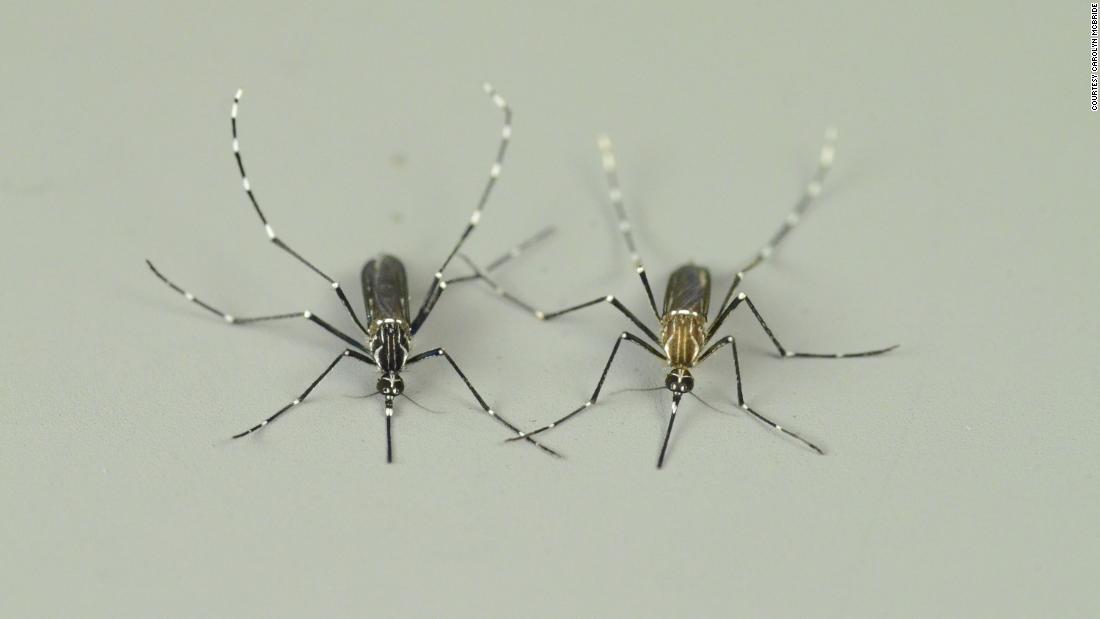
Understanding how mosquitoes smell humans could save human lives

CNN —
Of the more than 3,000 species of mosquitoes in the world, just a small number have evolved to specialize in sucking human blood.
How human-biting mosquitoes track us down so effectively isn’t currently known, but it matters, since they don’t just make us itch. They also carry dangerous diseases such as Zika, dengue, West Nile virus and malaria that can be deadly.
In fact, stopping these pesky insects in their tracks could save up to half a million lives lost to those diseases each year.
“In each of those cases where a mosquito has evolved to bite humans — which has only happened two or three times — they become nasty disease vectors,” said Carolyn “Lindy” McBride, an assistant professor of ecology and evolutionary biology at the Princeton Neuroscience Institute in New Jersey.
That’s why she wants to understand how they find and target humans.
“Mosquitoes mostly choose what to bite based on odor,” said McBride, whose lab focuses on the Aedes aegypti mosquito species that evolved to bite humans specifically.
Only female mosquitoes suck blood since they need it to produce their eggs. Knowing how a potentially disease-carrying female mosquito sniffs out a person, while ignoring other warm-blooded animals, is a key query.

Once that’s better known, much more effective repellents — or bait to lure mosquitoes away from humans — could be made, saving lives, said Christopher Potter, associate professor of neuroscience at Johns Hopkins University’s Center for Sensory Biology.
If scientists can control their sense of smell, “we can really control what these mosquitoes are doing,” said Potter, who studies another human-specific mosquito, Anopheles, which carries malaria.
It’s not an easy question to answer, since any animal smell is made up of hundreds of chemical compounds mixed together in specific ratios.
“The actual chemicals that are found in human odor are basically the same as the chemicals found in animal odor — it’s the ratios and the relative abundance of those compounds in human mixtures that’s unique,” said McBride, whose research focuses on those issues.
Each time a hungry female mosquito flies by, it’s doing complex chemical math in its tiny brain, figuring out what’s a human, what’s dog and what’s a flower.
“To investigate, we decided to record neural activity in the brain of females while exposing them to natural human and animal odor extracts,” wrote Zhilei Zhao, a graduate student in McBride’s lab, in a Twitter thread describing the lab’s work. It took four years to develop “the necessary genetic reagents, odor delivery systems, and analytical approaches,” Zhao wrote.

McBride’s lab team created a library of the chemical composition of animal odors. “That data set doesn’t really exist — so we decided to go out and collect it ourselves,” said Jessica Zung, a graduate student in McBride’s lab.
Zung has collected scent samples from about 40 different animals so far, including guinea pigs, rats, quail and more.
Comparing some of those to the 16 human samples, something jumped out. Decanal, a simple, common compound, is particularly abundant in human skin, Zung said.
Ubiquitous in the natural world, in humans, decanal comes from another, more complex compound. Zung dug into the archives to find research from the 1970s (much of it originally done to find an acne cure) that detailed how when one component of our skin’s natural oils, sapienic acid, breaks down, decanal is left over. This acid (as indicated by its name) is only found in human beings. It’s what likely leads to the high levels of decanal that help the mosquitoes smell their way to us, but more studies need to be done.
Understanding what the mosquitoes are sniffing out is only part of the story; knowing how they do it is also important. To see exactly how mosquitoes use this sense, scientists bred genetically modified Aedes aegypti mosquitoes “so that we could cut open their little tiny heads and put them under a fancy microscope and actually watch neurons firing when they’re exposed to human and animal odors,” McBride said.
The research team already knew that mosquitoes have about 60 different types of neurons that sense odors, so when they looked in the insects’ brains, they thought they might see a lot of activity. But it was surprisingly quiet, meaning that the signal was perhaps quite simple, down to just a couple types of neurons.
“One type of neuron responded really strongly to both humans and animals. Another type of neuron responded to both — but it responded much more strongly to humans than animals,” McBride said of that work. So it may be as simple as that mosquito’s brain comparing just two types of neurons.
This kind of research has only been possible since the technology to study mosquito brains in detail became available, which only happened recently. “It’s been traditionally very hard to study this at the level we’re doing it now,” Potter said.
Incredibly, mosquitoes that target humans have evolved to be able to do this in just the last 5,000 years, so it’s a “really amazing example of rapid evolution,” McBride said.
The Aedes aegypti, aka “yellow fever mosquito” also carries dengue, Zika and chikungunya. The critter originated in Africa and likely made its way to its current range in the southern United States and Central and South America on slave ships during the 1600s, according to McBride.
These diseases combined kill and sicken thousands of people a year, which is why mosquitoes have been called “the world’s deadliest animal” by the US Centers for Disease Control and Prevention. McBride and Potter both hope their work could be used by others working on repellents and attractants to prevent disease.
As far as insider knowledge on how to keep from being bitten in your own backyard, McBride said she uses a fan.
“Have it blow air over where you’re sitting outside or over the barbecue or under the table where they’re biting your feet.” It’s not that you’re blowing the scent around to knock the mosquitoes off track, she said.
It’s simply because these deadly creatures, McBride said, “are not great fliers.”
Source: https://www.cnn.com/2020/12/26/health/mosquito-bites-human-disease-wellness-scn/index.html


















